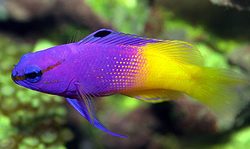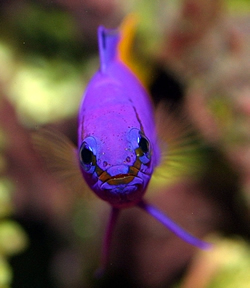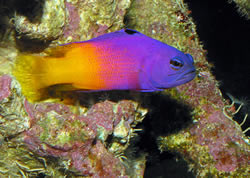|
The family Grammatidae, also commonly
known as Grammas, is the third Basslet family I've discussed
in this column. I'm sure this may be confusing to many people,
as I've already discussed two distinct families of fish that
are commonly called Basslets. To compound this confusion further,
there are actually four distinct families that are referred
to as Basslets: Plesiopidae, Pseudochromidae,
Grammatidae, and Serranidae. For the remainder
of this article, I'll refer to Grammatidae as Grammas.
About the Family
| |
•brasiliensis
•linki
•loreto
•melacara |
|
| |
•anabantoides
•evides
•flavescens
•klayi
•regia
•robinsi
•rosea
•trilineata |
Courtesy of Catalog
of Fishes |
|
Grammas have an interrupted or absent lateral
line, one spine and five soft rays on the pelvic fins, and
eleven to thirteen spines on the dorsal fin (Fish
Base). All are deepwater fish. In fact, Lipogramma
spp. are rarely seen in the hobby because they are normally
found at depths greater than 400 feet. I will, therefore,
discuss only Gramma.
Gramma spp. are found in the tropical
Western Atlantic from the northern tip of the Bahamas, to
Venezuela. They are not indigenous to the Florida Keys; however,
Gramma loreto has established itself from southern
Florida throughout the Keys mostly due to irresponsible hobbyists
releasing captive aquarium specimens (Courtenay, 1995).
Grammas are protogynous hermaphrodites;
that is, all males were once sexually functional females.
When the dominant male gramma dies (or otherwise disappears),
and another male doesn't inherit the territory, the dominant
female fills the void left by the missing male and the sex
change begins. Shortly thereafter, the female becomes a dominant,
sexually functional male. When the female of a pair dies,
another female will fill the void.
In the Wild
Gramma spp. generally prefers to
colonize highly rugose deepwater walls or reef slopes where
cover is abundant. Crevices, cracks, sponges, corals, overhangs,
caves, or anything that provides suitable cover, will usually
have a Gramma of one species or another. They will
spend most of their time with their heads sticking out of
their preferred hiding spot or hanging upside down from the
roof of their cave. They feed on zooplankton, primarily copepods
and isopods. On occasion, individuals will clean parasitic
isopods of other fishes. They have been observed cleaning
yellowtail snappers (Ocyurus chrysurus) and the Nassau
grouper (Epinephalus striatus) (Coral
Realm). Their unusually large mouth for a zooplanktivore
provides Grammas with their only means of defense. A large,
wide-open mouth is displayed to defend against most attackers,
including congeners. If this defense is insufficient, they
are likely to flee into protected areas of the reef.
In the Home Aquarium
All Grammas are exceptional choices for
the home reef aquarium. They will not bother sessile corals
or mobile invertebrates, including shrimp. Most suitable tank
mates are ignored (see graph). Overall, they are very resistant
to disease. They do, however, have a few special requirements
to ensure their well being.
|
Fish
|
Will
Co-Exist
|
May
Co-Exist
|
Will Not
Co-Exist
|
Notes
|
|
Angels, Dwarf
|
X
|
|
|
Good choice for aquariums
larger than 55g.
|
|
Angels, Large
|
X
|
|
|
Good choice provided
the tank is large enough for the angel.
|
|
Anthias
|
X
|
|
|
Good choice in larger
tanks; risky in small tanks (both planktivores).
|
|
Assessors
|
|
X
|
|
Assessors may suffer
in smaller aquariums.
|
|
Basses
|
|
|
X
|
Larger Basses may attack
and possibly consume smaller grammas.
|
|
Batfish
|
|
X
|
|
Batfish attain an adult
size that will keep the Gramma in hiding.
|
|
Blennies
|
X
|
|
|
Good choice.
|
|
Boxfishes
|
X
|
|
|
Good choice in larger
aquariums.
|
|
Butterflies
|
X
|
|
|
Good choice in larger
aquariums.
|
|
Cardinals
|
X
|
|
|
Good choice.
|
|
Catfish
|
|
X
|
|
Catfish row large enough
to consume Grammas.
|
|
Comet
|
X
|
|
|
Good choice in larger
aquariums with plenty of rockwork.
|
|
Cowfish
|
X
|
|
|
Good choice in larger
aquariums.
|
|
Damsels
|
|
|
X
|
Damsels steal the den
of Grammas; consume Gramma eggs.
|
|
Dottybacks
|
|
|
X
|
Not recommended. Only
possible exception is P. fridmani in large aquariums
with plenty of rockwork.
|
|
Dragonets
|
X
|
|
|
Will co-exist peacefully.
|
|
Drums
|
|
X
|
|
Small Drums in first,
once acclimated follow with a larger Gramma.
|
|
Eels
|
|
|
X
|
Not recommended. Most
eels will get large enough to consume Grammas.
|
|
Filefish
|
X
|
|
|
Good choice provided
the needs of the Filefish are met.
|
|
Frogfish
|
|
|
X
|
Frogfish will consume
Grammas.
|
|
Goatfish
|
X
|
|
|
Should be good tank
mates.
|
|
Gobies
|
X
|
|
|
Good choice. Goby in
first.
|
|
Grammas
|
|
X
|
|
Should co-exist in
4’ long tanks with plenty of LR.
|
|
Groupers
|
|
|
X
|
Groupers will consume
Grammas.
|
|
Hamlets
|
X
|
|
|
Should be good tank
mates.
|
|
Hawkfish
|
|
X
|
|
Some Hawkfishes can
become aggressive towards smaller tank mates.
|
|
Jawfish
|
X
|
|
|
Good choice provided
the tank has open sandbed for the jawfish and a LR shelf/wall/cave
on the opposite side.
|
|
Lionfish
|
|
X
|
|
Larger adults can consume
Grammas.
|
|
Parrotfish
|
X
|
|
|
Parrotfish should ignore
Grammas, though their adult size might be intimidating
to the Gramma.
|
|
Pineapple Fish
|
X
|
|
|
Should do fine together
provided there are plenty of hiding spaces.
|
|
Pipefish
|
|
|
X
|
Pipefish are often
delicate and small. Best kept to a species tank.
|
|
Puffers
|
|
X
|
|
Some puffers may be
too aggressive for Grammas.
|
|
Rabbitfish
|
X
|
|
|
Good choice in larger
tanks.
|
|
Sand Perches
|
|
X
|
|
Gramma in first. Sand
Perch may become aggressive once acclimated.
|
|
Scorpionfish
|
|
|
X
|
Adults can consume
Grammas.
|
|
Seahorses
|
|
X
|
|
Can be kept together
provided the needs of the Seahorse are met.
|
|
Snappers
|
|
|
X
|
Snappers will consume
Grammas.
|
|
Soapfishes
|
|
|
X
|
Soapfishes may consume
smaller Grammas
|
|
Soldierfish
|
|
|
X
|
Adults can consume
Grammas.
|
|
Spinecheeks
|
X
|
|
|
Should be good tank
mates.
|
|
Squirrelfish
|
|
X
|
|
Adults can consume
Grammas.
|
|
Surgeonfish
|
X
|
|
|
The active swimming
of the surgeonfish will keep the Gramma close to home.
|
|
Sweetlips
|
|
|
X
|
Can become large enough
to consume Grammas.
|
|
Tilefish
|
|
X
|
|
The aggressive swimming
of Tilefish may keep Grammas hiding.
|
|
Toadfish
|
|
|
X
|
Toadfish will consume
Grammas.
|
|
Triggerfish
|
|
|
X
|
Most Triggerfish are
too aggressive for Grammas.
|
|
Waspfish
|
X
|
|
|
Should be good tank
mates. Gramma in first.
|
|
Wrasses
|
X
|
|
|
Good choice provided
the tank is large enough for intended wrasse.
|
The biggest concern for the aquarist should
be in providing them with a hiding spot. The more rockwork
present, the more comfortable your Gramma will feel. Make
sure there are several caves and overhangs for the Gramma.
More often than not, they will choose one, and make it their
home. If you do not provide a shaded overhang in your viewing
area, they will hide, and you may only see them during feeding
time. Providing overhangs and caves is especially important
for brightly lit tanks. Simulating a deeper water environment
with an actinic light is another excellent means of viewing
your Gramma.
Food will only be consumed by Grammas when
floating in the water column. Good foods for stimulating great
coloration and vitality should include some of the following:
mysis, plankton, enriched frozen or live brine, small pieces
of squid or crab, and various carnivore flake or pellet foods.
Additionally, vitamins should be added to the foods. Soaking
freeze-dried plankton or live brine shrimp in liquid vitamins
is an effective way to deliver it to the fish. Grammas are
usually aggressive eaters and will consume most foods that
enter the tank.
Captive Reproduction
Spawning in the home aquarium can, and
does, happen in Grammatidae. Gramma spp. were
the first marine fish bred within the U.S.A (Baensch, 1994).
Unfortunately, the hobby still relies heavily upon wild capture
to keep up with demand for this fish.
For the hobbyist interested in spawning
Gramma sp., a tank at least four feet in length should
be used. A male will defend up to 560 square feet (Coral
Realm). For reference, a 55 gallon aquarium is 576 cubic
inches. Grammas can be aggressive to congeners, especially
when two males are mixed. To minimize the risk of adding two
males, it is best to find two Grammas that are vastly different
in size. The largest Grammas are always the males or will
become the male when paired with smaller Grammas.
The male will prepare the den, which usually
consists of various algae species, sponges, gorgonians, and
urchin spines (Coral
Realm). These materials are regularly replaced as they
decompose. The den is built into a hole in the rockwork with
access limited to a single entrance/exit. Any secondary entrances
to the den are covered so that only one entrance/exit exists.
The female will be lured into the den where she will lay the
eggs. Depending upon the species, the female will lay up to
400 eggs. Both the male and female will guard the eggs until
they hatch in the evening of the seventh day. The fry are
well developed, have a yolk sac, and within one month they
will have adult pigmentation. At hatching, G. melacara
measures roughly 3mm, with G. loreto and G.
brasiliensis being slightly smaller. First foods offered
to the fry should include Nannochloropsis sp. and Isochrysis
sp., and within two weeks the fry should be large enough to
consume newly hatched Artemia (C~Quest, 1994).
Meet the Species
Gramma loreto, a.k.a. the
Royal Gramma or Fairy Basslet, is one of the more common fish
in the hobby. Outdated references will list this fish as G.
hemichrysos. It is found throughout the Caribbean at depths
of 3 - 120 feet, though it is most common below 60 feet. At
all times, it will keep its bottom side towards a solid structure.
Therefore, whenever this fish is hovering below the roof of
a cave, it will be upside down (Spiekerman 1973).
 |
 |
|
Royal Gramma
|
The Royal Gramma can reach
three inches in length and can be kept singly in a 20 gallon
or larger aquarium. Selection of suitable tank mates is tricky
in tanks as small as 20 gallons. Consider making the Gramma
the largest inhabitant, and add it last. For a community aquarium,
a 55 gallon tank or larger would be a better choice. If Gramma
loreto is the lone species in a larger tank, a harem can
be maintained. Gramma loreto has been found in concentrations
as high as 116 individuals on a single coral head measuring
20 feet in diameter (Coral
Realm). To attempt this in the home aquarium, try to ensure
you obtain one male while the remaining animals are female.
Males will fight for territory. If your tank is not large
enough for the given number of males added, you will have
problems.
Gramma brasiliensis, the Brazilian
Gramma, is extremely similar to Gramma loreto. The
only notable differences are their origin and a few minor
cosmetic differences. Gramma brasiliensis is only found
in Brazil, and visual differences occur in the jaw line, dorsal
fin, and their slightly different coloration. Gramma brasiliensis'
jaw line extends slightly past the pupil, and the first dorsal
spine is noticeably shorter than the rest of the spines (Coral
Realm). Brazilians violet is not as intense as G. loreto,
and the fade from violet to yellow is more gradual.
 |
|
Brazilian Gramma
|
Gramma melacara is
known commonly as the Blackcap Basslet. The species name melacara
comes from the Greek roots "melaen," meaning
black or blacken, and "car = a," meaning
the head or top. This species is found deeper than either
G. loreto or G. brasiliensis. Rarely do they
venture above 60 feet, being more commonly found below 100
feet. The depth required for collection also means a higher
price found in stores. They do get larger than the other Grammas,
growing to four inches in length. Unlike G. loreto
and G. brasiliensis, G. melacara will not be
found in large groups. Instead, they will be found as lone
adults, or in small aggregations. This behavior should be
mimicked in the home aquarium by keeping only one Blackcap
per aquarium, except for exceptionally large home aquariums
(>200 gallons).
Blackcap Basslet
The last Gramma sp.
to mention is G. linki. It is also commonly referred
to as the Yellowlined Basslet. This species rarely shows up
in the hobby, mostly because they are not found shallower
than 120 feet.
Conclusion
Grammas are an interesting group of fish.
Their comical behavior of hanging upside down and their interesting
personality adds even more enjoyment to an exceptionally colorful
group of marine fish. When you combine their personality and
beauty with their overall hardiness, you have a perfect choice
for the reef aquarium.
|

